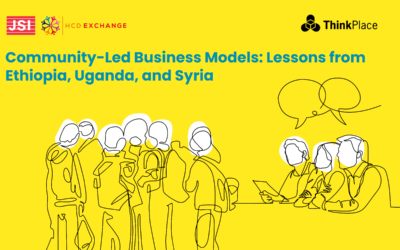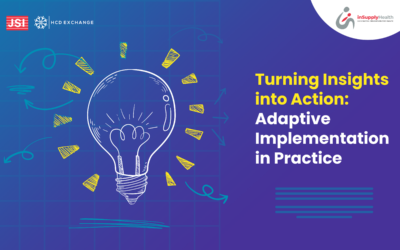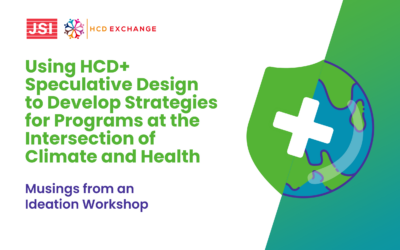Looking back at our efforts towards building a HCD+ASRH community in 2020
Through a facilitated mural board exercise, the HCD+ASRH community of practice reflected on some key moments where our community collaborated and connected. A few highlights included the co-creation of the community strategy, the development of a learning agenda for the HCD + ASRH community, the International Youth Day convening, engagement with the Voice Up platform, co-creation of the community fundamentals, and participation in the various webinars covering the opportunities and challenges of integrating design in ASRH.
Beyond the reflections, we heard from the community on the need to move into 2021 with increased clarity on engagement opportunities for HCDExchange community members, and the desire for our community to continue to deepen diversity and inclusion, particularly through integration of adolescent youth from different regions within the community. The desire to share learnings and experiences in the field of HCD + ASRH also stood out as an important priority for 2021. We’re grateful for these important inputs which we will use to guide our work.
Exploring learning and deepening community engagement on HCD+ASRH in 2021
As part of a panel discussion on the community call, the HCDExchange community highlighted some important considerations to take forward and explore in 2021. Some of the themes and questions that emerged on the call are highlighted below:
Young people are not homogenous
Community members highlighted the diversity of youth, noting that there exist various segments and groups that have their own needs, aspirations and experiences. How might we as people working in or thinking about the HCD + ASRH field advance the rights and needs of all young people and not just those who are easily accessible? How do we involve adolescent youth groups that have not been reached for decades?
HCD requires rigor in execution but also draws on aspects like intuition, creativity, and empathy, all of which play an important role in the final outcome.
While we acknowledge the critical need to have quality measures and standards for the HCD process in the ASRH programming space, how might we leave room for aspects like intuition, creativity, and empathy when developing quality measures and standards for HCD in ASRH?
HCD is an agile and flexible process which can be applied to various scenarios.
For this reason, it’s therefore important to develop frameworks that can provide guidance on the applicability of HCD in programme design for sexual health among adolescents. What are the different ways in which HCD can be used? Is it something that is adapted differently at different points in the lifecycle of a programme? And more specifically, what does HCD mean in the context of implementation of programme design, or adaptation of programmes in different contexts? How can we apply HCD in those scenarios and achieve quality outcomes?
While it is fairly clear that we need appropriate measurement and evaluation metrics or frameworks for the HCD process, a lot has changed in the last year that should cause us to innovate the way we approach evaluation.
In 2020 we’ve all been forced to work remotely and we’re now often unable to tap into the human connections that power HCD. In our current context, it has become crucial to think about the quality of our work and how we might hold ourselves accountable to high standards in this new context. One of the key questions to ask is, how might we develop appropriate monitoring and evaluation frameworks that are fit for purpose within our current reality?
As we think about documenting successes and failures around HCD, there is the need to make a distinction between evidence and learning.
How might we account for this distinction, and create metrics and/or frameworks that can encompass both? To begin to answer that question, one of the crucial points that came up is the importance of documentation. How might we ensure appropriate documentation during the HCD process that will support evidence generation and learning and enable appropriate data collection for evaluation?
HCD has enabled greater integration of data points and insights that were otherwise being missed.
Through HCD, previously unexplored topics and lived experiences are now being centred and integrated into our overall understanding of the challenges adolescents face. How might we keep in mind the integration of previously unexplored data points when thinking about quality and standards, evaluation, and processes for the HCD + ASRH field?
Closing thoughts
As we begin to look at what it will take to answer some of the important questions in the HCD + ASRH field, here are some of the recommendations the community thought would make an impact:
Focusing on creating inclusively with youth and genuinely listening to every stakeholder’s voice in the ecosystem
Alongside the youth, other voices to be attentive to include advocates and activists, programme implementers, evaluators, funders, designers, policymakers etc). This can be done by identifying areas of focus and sharing learnings together, and keeping the values of sharing, honesty, and respect at the core of our interactions.
Involving young people at every stage of the process.
Start involving them at the start of the process and all through to the monitoring period in order to understand what indicators matter to them, and make those part of the programme design process. Try and think outside of the systems developed by funders, and towards a system that is led by young people, in this case the humans we are designing for. To authentically partner with youth may require slowing down the process overall, but this is the avenue to achieve genuine youth participation.
The right thing to do (meaningful youth engagement) and what makes business sense (return on investment) don’t always align.
A key question for stakeholders in the ecosystem to consider is : when and how do we make efficient trade offs between these two competing priorities, and what are the implications on the sexual health outcomes for young people?
Join our HCD+ASRH learning community
Thank you for your active participation in community events this year. If you haven’t signed up to join the HCDExchange community of practice, please review the Community Participation Guidelines and tell us a little about yourself. We look forward to a year of listening, sharing, discussing, and creating with you! Wishing you a good end to 2020 and a fruitful 2021.
—-
(Special thanks to our community call facilitators – Christabel Nentondo, Gabriel Mutua, MaqC Eric Gitau and our discussants – Claire Cole, Ipsa Agnani, Emmanuel Diop, and Rimjhim Surana)
Please find the link to the our community call documents here:
Call 3: Looking back at 2020, Looking forward to 2021 / December 17, 2020 / 4:30 pm EAT
Call 2: The “Who” and “How” of the HCDExchange COP/ November 4, 2020 / 4:30 pm EAT



